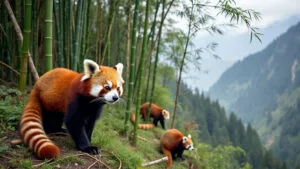Introduction
Red pandas play a vital role in the ecosystems of the Himalayan and temperate forests of Asia. Known for their bamboo-centric diet, these unique animals influence not only the flora they consume but also impact the animals and environmental balance around them
Through this article, we’ll explore how red pandas affect their habitats’ food chain, including their interactions with bamboo and other plants, their ecological position between predators and prey, and their relationships with other forest species
Additionally, we’ll consider how the conservation of red pandas is crucial for maintaining ecosystem health and diversity
Diet of the Red Panda and Its Impact on Ecosystems
Red pandas are well-adapted to their mountainous, forested habitats, primarily eating bamboo, which accounts for over 90% of their diet. This dietary specialization shapes their ecological role and influences the surrounding plant and animal life in various ways
Their diet and foraging behaviors contribute significantly to the health and diversity of forest ecosystems by controlling plant growth, providing habitats for smaller creatures, and affecting nutrient cycles within the soil
The Bamboo Diet and Its Ecological Role
Bamboo, a fast-growing grass, provides the bulk of the red panda’s diet. Red pandas consume bamboo leaves, shoots, and stems, which are abundant in their high-altitude forest habitats
The way red pandas selectively graze helps control bamboo overgrowth, which can be beneficial to the forest ecosystem. Studies have found that bamboo forests with healthy red panda populations are often more biodiverse, as the pandas prevent any one bamboo species from dominating and crowding out other plant life
Research published in the Asian Forest Journal (2021) highlights how red pandas’ selective feeding habits promote healthier bamboo growth and create space for a variety of flora, which ultimately supports more animal species
In addition to maintaining bamboo diversity, red pandas impact the availability of bamboo shoots for other herbivores, such as deer and smaller mammals, by feeding on specific bamboo parts
This indirect influence helps shape the feeding behavior of other animals, as they may be drawn to or deterred from certain areas depending on the presence and feeding patterns of red pandas
Impact on Bamboo Forests and Biodiversity
The red panda’s role as a bamboo consumer goes beyond diet—it plays a critical part in preserving the balance of bamboo-dominant forests. Without this predator-prey balance between bamboo and red pandas, bamboo could either spread uncontrollably or diminish, impacting a wide range of forest-dwelling organisms
By regulating bamboo growth, red pandas support an environment where plant diversity can flourish. Studies conducted in the bamboo forests of Nepal (Journal of Wildlife Ecology, 2019) have shown that areas with active red panda populations feature greater plant diversity and are home to more species of small mammals and birds, which benefit from a more complex forest structure
How Red Pandas Shape Plant Life in Their Habitat
Red pandas contribute to nutrient cycling within their habitat by dispersing organic matter through their waste. As red pandas digest bamboo, they release nutrients into the soil through their feces, which fertilizes the ground and encourages plant growth
This nutrient recycling is essential in forested areas where organic matter accumulates slowly and is crucial for supporting a range of plant species that other animals depend on. Additionally, as red pandas forage, they often carry seeds on their fur and spread them to new locations, indirectly supporting plant propagation across their range
According to a study in the Journal of Environmental Science (2020), the presence of red pandas positively impacts plant regeneration rates and soil health, promoting long-term ecological stability in their native forests
Red Pandas’ Place in the Food Chain
Red pandas occupy a unique and somewhat delicate position within the food chain of their temperate forest ecosystems. As primary consumers of bamboo, red pandas are mainly herbivores, but they occasionally eat small mammals, eggs, and insects
This diet places them in a mid-level trophic position, influencing both the vegetation they consume and the predators that hunt them. Their interactions within the food chain help balance the population dynamics of several species, from plant life to top predators
Predators of the Red Panda
While red pandas are not at the top of the food chain, their primary forest habitats often limit the number of natural predators they encounter
However, they are occasionally preyed upon by snow leopards, martens, and birds of prey, which see red pandas as a food source, especially young or injured individuals. The presence of these predators helps regulate red panda populations, ensuring that bamboo and other resources are not overexploited
Research published in the Journal of Conservation Biology (2018) highlights how the snow leopard and red panda populations coexist in regions of the Himalayas, where both animals help control prey species populations and maintain biodiversity. This predator-prey relationship underscores the importance of a balanced ecosystem in supporting a wide range of species
The limited predation on adult red pandas also suggests a naturally low mortality rate in stable habitats, allowing them to maintain a relatively small but consistent population
Nevertheless, as human encroachment and habitat fragmentation increase, predators sometimes seek red pandas closer to human-populated areas, intensifying the challenges these animals face
Red Pandas’ Effect on Smaller Animals and Insects
Red pandas affect several smaller animals and insect species through their feeding and nesting habits. As they forage primarily on bamboo and occasionally on insects, red pandas influence the population sizes and behaviors of these organisms
By consuming bamboo, they indirectly shape the habitat structure, creating sheltered areas for small mammals, reptiles, and various insects. This controlled bamboo growth ensures a diverse microhabitat that many small species rely on for food and protection
Insects, which are part of the red panda’s supplementary diet, may be affected by the pandas’ seasonal dietary changes. For instance, when red pandas forage more heavily on bamboo in the winter, insects that share similar food sources can experience reduced competition
This dynamic helps balance insect populations, ensuring that no single species dominates. Furthermore, red pandas contribute to maintaining a balanced insect population, indirectly affecting the food sources of birds and other insect-eating animals in the ecosystem
The Role of Red Pandas in Nutrient Cycling
One of the lesser-known but critical roles red pandas play in their habitat is their contribution to nutrient cycling
Red pandas consume large quantities of bamboo and other plants, and their waste returns essential nutrients to the soil. This nutrient deposition enriches the soil, promoting healthy plant growth and supporting an array of organisms that depend on these plants
The cyclical process of consumption and waste deposition creates a self-sustaining nutrient loop that supports both plant and animal life within the ecosystem. A recent study published in Animal Ecology Journal (2022) found that the regions populated by red pandas have significantly healthier soil composition and plant diversity than regions without them
This role in nutrient cycling is especially vital in temperate forests, where decomposition rates are slower, and nutrient availability can be a limiting factor for plant growth
By continually contributing organic material back into the soil, red pandas support a sustainable environment for countless organisms, from microscopic soil bacteria to larger animals that rely on healthy plants
Ecological Relationships with Other Species
Red pandas interact with a variety of species within their forest ecosystems, and these relationships play a vital role in maintaining a balanced and diverse environment
From symbiotic associations to competitive dynamics, red pandas influence and are influenced by the other species sharing their habitats. Understanding these relationships helps highlight the broader ecological roles of red pandas beyond their dietary impact
Symbiotic Relationships in the Forest
Red pandas participate in symbiotic relationships, especially with certain plants and smaller animals that benefit from their presence. As red pandas forage and move through the forest, they sometimes assist in seed dispersal
Though primarily bamboo eaters, red pandas consume small amounts of other vegetation, including berries and various fruits when available. Seeds from these fruits can pass through their digestive systems and be deposited in different parts of the forest, facilitating plant propagation
The Journal of Environmental Science (2020) notes that seed dispersal by red pandas, while less common than by other animals, contributes to plant diversity, particularly in temperate forests where plant regrowth can be slower
Additionally, the red panda’s habit of stripping bark or breaking branches to access bamboo can create microhabitats for insects, fungi, and small plants that thrive on decomposing wood
This incidental contribution supports a wider range of species and fosters biodiversity in the forest understory, highlighting the indirect yet significant influence red pandas have on their ecosystem
Competitors and Cohabitants in the Ecosystem
Despite their dietary specialization, red pandas do face competition from other herbivores, such as certain deer and wild goats, that also consume vegetation in the forest. During seasons when bamboo is less available, competition for alternative food sources, such as fruits or small invertebrates, can increase
However, red pandas typically avoid direct competition by adapting to different feeding times or seeking out areas less frequented by other herbivores. This behavioral adaptation minimizes food-related conflicts and helps preserve biodiversity by allowing multiple species to share limited resources in the same habitat
Red pandas are also known to share their habitat with various small mammals, birds, and insects that depend on bamboo forests for food and shelter
Studies from the Asian Forest Journal (2021) indicate that red pandas have minimal direct competition due to their specialized diet, but they contribute to resource availability for other species. By regulating bamboo growth, they prevent a monoculture that would otherwise reduce biodiversity, thus supporting an array of other animals
Red Pandas and Their Role in Forest Health
The red panda’s unique feeding and foraging behaviors contribute directly to forest health. As they navigate through different sections of the forest, they help keep the bamboo population in check and encourage growth in various locations, which in turn stabilizes the forest structure
This balanced approach to consumption prevents overgrazing in any single area and sustains a dynamic environment that accommodates a diverse range of plants and animals
Moreover, red pandas’ interaction with the forest floor through digging, climbing, and nesting can influence soil composition and plant regeneration rates. By disturbing soil lightly as they move or dig for roots, they create small patches of bare ground that serve as ideal spots for new seeds to take root
This indirect support of plant growth benefits species that rely on fresh vegetation, ensuring that forest resources remain renewable and resilient to environmental stressors
As a keystone species in their ecosystem, red pandas significantly contribute to maintaining biodiversity, supporting soil health, and balancing plant and animal populations. Their presence and interactions with other species highlight their critical role in temperate forest ecosystems
Conservation of Red Pandas and Ecosystem Balance
The conservation of red pandas is essential not only for preserving this unique species but also for maintaining the health and balance of their ecosystems. Due to habitat loss, poaching, and climate change, red panda populations are in decline
This reduction has far-reaching impacts on biodiversity, as red pandas play a significant role in their forest environments. Conservation efforts are critical to safeguarding these habitats, ensuring that the ecological roles red pandas fulfill remain intact
Effects of Red Panda Decline on Ecosystems
When red panda populations decrease, the effects ripple throughout the ecosystem. Bamboo forests, which rely on red pandas to control growth and maintain diversity, can experience imbalances. Without the foraging habits of red pandas to check bamboo spread, certain bamboo species can overtake other plants, reducing biodiversity and habitat availability for other animals
Research in the Journal of Environmental Science (2020) showed that forests lacking red pandas often see a decline in plant species variety, which impacts all levels of the food chain
Furthermore, red pandas contribute to a stable nutrient cycle through their waste and selective feeding. A decline in red pandas means fewer nutrients are returned to the soil, which can affect plant health and growth
The absence of red pandas can therefore weaken forest resilience, making the ecosystem more vulnerable to diseases, invasive species, and other disruptions
Importance of Red Panda Conservation Efforts
Protecting red pandas goes beyond saving an endangered species; it involves preserving the entire ecosystem in which they live. Conservation groups like the Red Panda Network have established reserves and community programs across Nepal, Bhutan, and India to protect red panda habitats and reduce threats from logging and agriculture
These efforts help to stabilize red panda populations and, by extension, benefit the broader ecosystem. For example, conservation reserves in Nepal have not only seen red panda population growth but also increased plant and animal diversity, illustrating the positive impact that red panda protection has on the environment
Raising awareness and supporting local communities is another key aspect of conservation. Programs that educate communities about the ecological importance of red pandas reduce human-wildlife conflict and foster a collaborative approach to wildlife preservation
Additionally, eco-tourism initiatives in red panda habitats have brought economic incentives for local populations to support conservation efforts, creating a positive feedback loop that helps sustain these endangered animals and their ecosystem
Impact on Ecosystem Diversity and Stability
Red panda conservation has broader implications for biodiversity and ecosystem stability. As a keystone species, red pandas help sustain other species in their habitat, from bamboo plants to small mammals and insects
Ecosystems with stable red panda populations tend to be more resilient and capable of withstanding environmental pressures, such as climate change and invasive species. Maintaining this stability helps ensure that these forests continue to support diverse plant and animal life, providing long-term ecological benefits
Conservation actions that focus on protecting red pandas ultimately protect a wide range of flora and fauna. By preserving red panda habitats, conservationists help safeguard numerous species, creating a network of ecological benefits that extend throughout the food chain
The preservation of these temperate forests is crucial not only for the animals residing within but also for global biodiversity, as these forests play a role in carbon sequestration and climate regulation
In sum, red panda conservation efforts are essential to preserving both this iconic species and the health of the unique ecosystems they inhabit. Protecting red pandas ensures that their habitats continue to function and support the diverse range of life that depends on these environments
Conclusion
Red pandas play an integral role in maintaining the ecological health of their habitats, acting as both regulators of bamboo growth and contributors to nutrient cycling
Through their diet and interactions with other species, red pandas help support plant diversity and provide food sources and shelter for smaller animals, creating a balanced forest ecosystem
Their position within the food chain links them to both plant and animal life, shaping the structure and diversity of the forests they inhabit
As red panda populations face threats from habitat destruction, climate change, and human activities, the need for conservation becomes more pressing. Protecting red pandas not only saves an endangered species but also preserves the biodiversity and stability of temperate forests, ensuring that these ecosystems remain resilient and supportive of countless other species
Conservation efforts, including habitat protection and community education, are critical to maintaining the ecological roles red pandas fulfill, highlighting the interconnectedness of all species within an ecosystem
In safeguarding the red panda, we protect a complex network of ecological relationships, supporting the health and longevity of forest ecosystems and promoting biodiversity on a global scale











